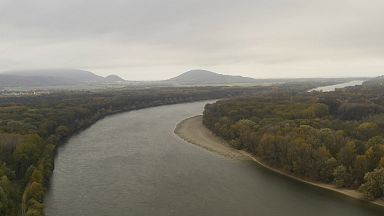Smart Regions looks at how researchers and scientists find solutions to manage the Danube River sustainably after it has been modified with flood protections and hydro-power plants.
The Danube is an environmental treasure. But it's also one of the most modified rivers in Europe. Channeling, flood protections, and hydro-power plants have altered the natural balance. It’s the case between Slovakia and Austria.
Martin Glas, University of Natural Resources and Life Sciences, Vienna said, "There, is another reservoir starting, near Bratislava, and there we have more sedimentation”.
A large dam a few kilometres upstream blocks the flow of sediment. This can increase the risk of flooding, hinder navigation and affect water quality and ecology.
How research can identify problems in the river
Researchers measure the behavior of the river, looking at any imbalance between the sediment and the flow.
"When there is an imbalance, and there are more sediments and less power from the flow, there is sedimentation," said Katarina Holubova, Water Research Institute, Bratislava.
"And vice versa, when there are fewer sediments and more water, then there is erosion. All these problems and understanding these problems can lead us to create effective measures to improve the situation”.
Sharing knowledge
The DREAM project led by Prof. Helmut Habersack (BOKU) aims to promote knowledge sharing for improved sediment management on the Austrian-Slovak border. It has a budget of €13.5 million, 61% of which is financed by the European cohesion fund.
To better understand the morphodynamics of the Danube, scientists carry out simulations in a laboratory in Vienna.
Creating models
Computer-based models have been created to enable authorities and companies to make better decisions. But creating the right-sized models is a problem.
"In this small flume," explained Glas, "we have the problem that we have to scale the processes. And we can scale the width of rivers, and depths, but when we want to scale the sediments, we came into problems. So the less scaling (problem)we have the better it is.”
This is why a huge 1:1 scale hydraulic laboratory is being built in Vienna, with a unique discharge capacity of 10,000 litres per second, which is equivalent to 60 baths of water per second.
The improved research opportunities will allow the promotion of innovative measures for sustainable river management.
"Rivers are a lifeline in our environment," said Christine Sindelar, Head of Hydraulics Laboratory, University of Natural Resources and Life Sciences, Vienna.
"It's good for recreation, for humans, but of course also for animals and plants, so we need to restore river systems. We are really confident that with this hydraulics laboratory we can contribute a lot to solve our problems”.
Scientists hope their research will help restore the sediment balance in many rivers around the world.












